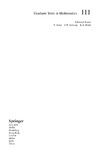Anyone who has studied elliptic curves appreciates their beauty and the richness of the mathematics that arises from such a study. This book, first published in 1987, has three additional chapters that reflect some major applications of elliptic curves since then. Indeed, the resolution of Fermat's Last Theorem due to Andrew Wiles and the use of a generalization of elliptic curves, called Calabi-Yau manifolds, in string theory have all taken place since the time of publication. The review here will be confined to these chapters.
Chapter 18 is a brief summary of the modular elliptic curves conjecture and Fermat's Last Theorem from mostly an historical perspective. The author reviews the material from prior chapters that relate to the modular curve conjecture. The Tate module of an elliptic curve plays a central role, with its structure as an l-adic Galois module allowing the author to formulate an alternative version of the modular curve conjecture. The author shows that the modular elliptic curve conjecture is equivalent to the assertion that every l-adic representation arising from a Tate module of an elliptic curve over the rational numbers Q comes from a modular form of weight 2, which is a Hecke eigenfunction.
It is fascinating that the connection between elliptic curves and Fermat's Last Theorem was only pointed out as late as 1986 by the mathematician Gerhard Frey. The relation of the `Frey curve', as it is now called, to Fermat's Last Theorem is discussed by the author, and he shows how it is reduced to the modular elliptic curve conjecture for semistable curves.
In chapter 19, the author introduces the reader to Calabi-Yau varieties, which are higher dimensional analogs of elliptic curves, and which have become very important in high-energy physics. The reader will have to have some background in the theory of complex manifolds to appreciate this chapter, but the author does a quick survey of the relevant topics. Of particular importance in this discussion are the Kahler manifolds, which can be thought of as complex manifolds with a metric that is an analog of the Euclidean metric in the real case, i.e. the metric is Hermitian and is closed.
After a further review of characteristic classes the author gives several equivalent definitions of Calabi-Yau manifolds, and several examples in (complex) dimension one, two, and three. He also gives examples of Calabi-Yau manifolds that arise from projective and weighted projective spaces, and their generalizations, the toric varieties. A brief remark is made concerning the existence of `mirror' Calabi-Yau manifolds, these latter objects currently the subject of intense research. Just as in the case of real manifolds, it is of interest to find invariants for Calabi-Yau manifolds that will assist in their classification. The author does this for the case of surfaces that are Calabi-Yau, and this naturally leads to the analog of the Euler characteristic in the guise of the famous Riemann-Roch theorem. The Riemann-Roch theorem though is not proven, but the author does show explicitly how to obtain the formula for the genus for the structure sheaf on the scheme defined by the ideal sheaf. A brief introduction to K3 surfaces is given. These surfaces are very important in physical applications and in four-dimensional topology.
Finally, in the last chapter of the book, the author studies families of elliptic curves. This is done in the context of the theory of schemes, and the author makes some connections with physics. The author gives a very brief review of scheme theory, starting with the notion of a `local ringed space', which is a topological space with a sheaf of rings defined on it such that the stalks are local rings for every point in the space. Local ringed spaces include smooth and complex analytic manifolds as special cases, and codify both the algebraic and analytic properties of the objects studied. An affine scheme is then defined as a locally ringed space isomorphic to the spectrum of a ring. A scheme is a locally ringed space locally isomorphic at each point to an affine scheme. The isomorphism classes of elliptic curves have the structure of a scheme.
Elliptic fibrations of surfaces over curves are studied in terms of their effective divisors, which are analogs of the canonical divisors used in the Enriques classification of surfaces. The Euler characteristic is then computed in terms of the effective divisor. The author then shows that a K3 surface with a Picard number at least 5 has an elliptic fibration. This is generalized to the case of Calabi-Yau varieties using the concept of a `numerically effective' divisor. Some explicit examples of Calabi-Yau hypersurfaces in four-dimensional weighted projective are then given. These examples were found by string theorists, and the author therefore devotes an appendix that describes how Calabi-Yau manifolds are used in high energy physics. The appendix is very short, and a perusal of the literature of string theory will reveal the overwhelming importance of Calabi-Yau manifolds. String theory has evolved into M-theories and membrane theories, but both of these involve heavy use of algebraic geometry, and many of the constructions are generalizations of what is known for the case of elliptic curves.
 |
|
О проекте
|
|
О проекте


